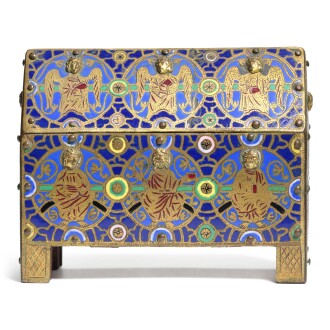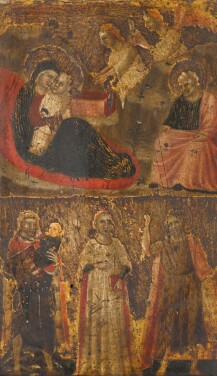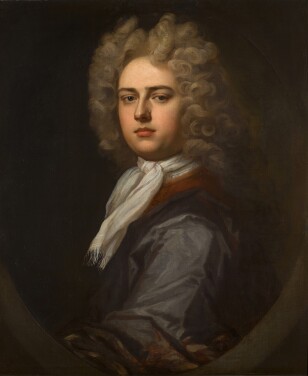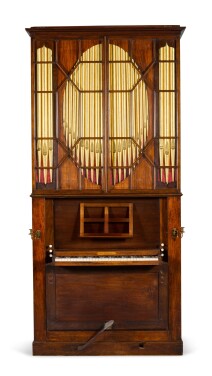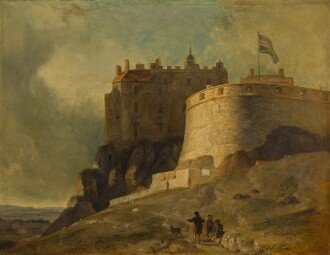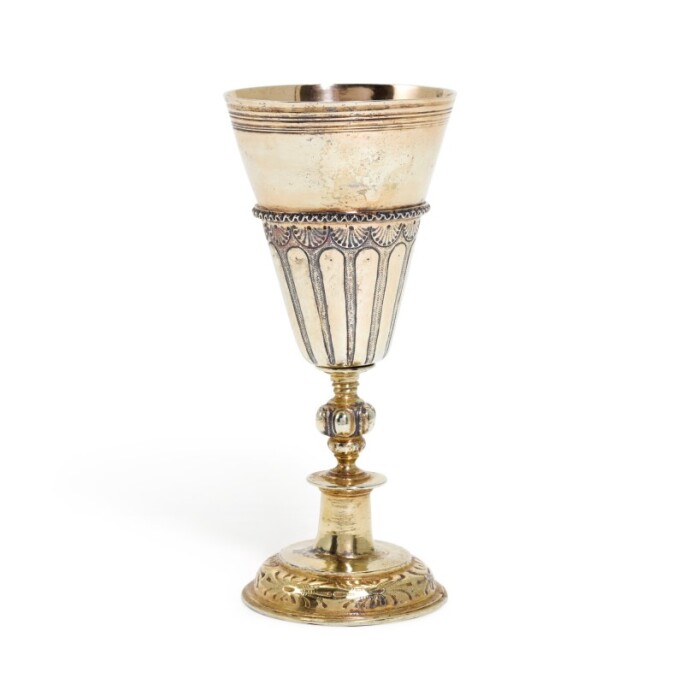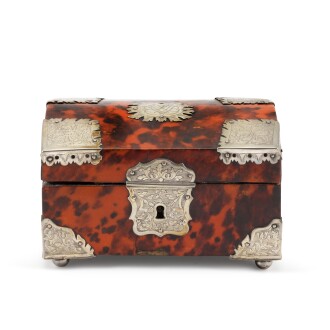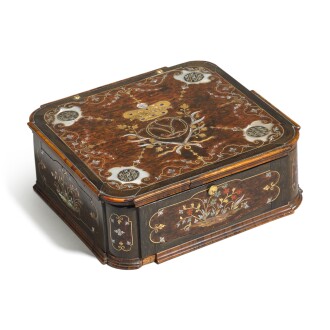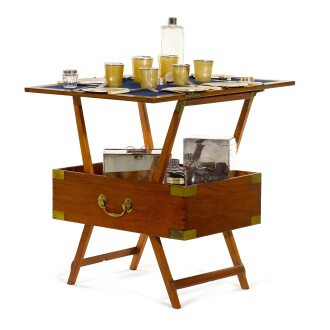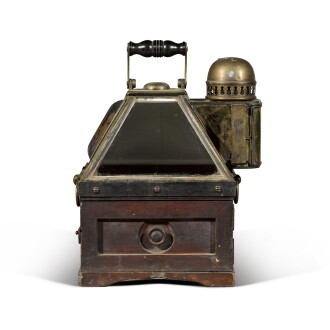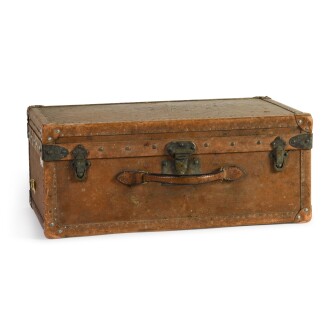"Noble Caledonia!" This year, the Royal and Noble sale has a distinctly Scottish character, encapsulating the spirit of collecting and patronage in the 18th and 19th centuries through an array of property with exceptional provenances. Discover precious objects from a Romantic castle on the Western Isles, a grand Ducal palace and the home of a highland chief amongst others. The sale includes heirlooms, many hidden from view across centuries, which tell not only the story of Scotland but also of the noble households of Great Britain, Europe and beyond. Notable provenances include a descendant of William Beckford & The Dukes of Hamilton, the Earl of Haddington, the descendants of William & Robert Adam, Lord Ralph Kerr and the Estate of The Rt Hon the Countess of Sutherland.
Sale Highlights

George IV’s historic visit to Edinburgh in 1822, the first by a British Monarch in 200 years captured the imagination of many, through reportage, prints and paintings – people saw the portly King dressed in long-banned Scottish (albeit idealised) national costume. The Royal visit was a theatrical tour-de-force organized with great pageantry by Sir Walter Scott (1771–1832). The writer did more than just establish this new King of Scotland, he helped ignite a cult for a re-booted version of Scotland’s past, furthered through his novels, which were consumed by an audience hungry for more. George IV’s famous outfit (replete with the comfort of mirth provoking woolley-tights) cost £1,354.18s. (£120,000 today) and was a concoction of bright red Royal Tartan and flamboyant accessories; including dirk, sword and pistols. It was indeed fit for a King, and later that century a new clan chief too, who was to be supplied with similar. The King had created an enduring legacy – and a sense of what was appropriate garb for a (wealthy) leader of men.
Highland Dress Regalia Fit for a Clan Chief
-
 Old Masters WeekThe Woman Who Changed the World of Master Drawings: Inside the Diane Nixon Collection
Old Masters WeekThe Woman Who Changed the World of Master Drawings: Inside the Diane Nixon Collection -
 Old Masters WeekHeld, Kissed and Hidden for 500 Years: The Most Intimate Antonello da Messina You’ll Ever See
Old Masters WeekHeld, Kissed and Hidden for 500 Years: The Most Intimate Antonello da Messina You’ll Ever See -
 Modern & Contemporary Middle EastFrom Binzagr to Picasso | Saudi Art Pioneers Meet Global Masters at Sotheby's Origins II
Modern & Contemporary Middle EastFrom Binzagr to Picasso | Saudi Art Pioneers Meet Global Masters at Sotheby's Origins II


The novels of Scott, in the romantic tradition, and earlier the glorious poetry of Burns created an almost mystical country in the mind’s eye of those outside Scotland’s borders – a landscape of misty mountains, mysterious glens, heroic characters and ancient fortresses. Dramatic paintings by artists like Sir Edwin Landseer (1802-1873), and importantly the prints produced of his work, and that others, captured not only Scotland’s landscape, but her animals and her ‘noble’ people, from across society.

Plate books were published which featured the nations stunning geography and architecture and often both, Dunrobin Castle in its dramatic Sutherland landscape was a popular choice. The Castle was to become the stuff of a children’s fairytale after enhancement by the architect of the New Palace of Westminster, Charles Barry between 1835 and 1850.


Victoria and Albert are commonly charged as being a part of the 19th century “romantic-isition” of Scotland and through their deep love of the Country they made it fashionable. Balmoral Castle (completed 1856) was in part designed by Victoria’s Bavarian Prince Albert, who identified with Scotland’s highlands which he felt recalled his homeland. A much-loved retreat for the family, and like Dunrobin, a fantastical continental-European concoction. Scotland now had a succession of Royal visitors – who collected not only pictures and tartan-y object d’art , but from the 19th century onwards, sometimes macabre, sporting trophies.


In 1843 another German Royal, Princess Marie Amelie of Baden (1817–1888) married William Hamilton, then Marquess of Douglas, who was to become the 11th Duke of Hamilton. In 1844 she began a process of aggrandisement at the family seat on Arran, Brodick Castle.
Her ambitious plans included the creation of state rooms which not only celebrated the lineage of the Hamilton family but reflected her native homeland, within a ‘Scottish Baronial’ guise. In the Dining Room for decoration, she chose an important ancestral silver plate, displayed in great quantity and triumphantly with new additions acquired by the Duke and Duchess (often German and along a hunting theme).

The castle was not just a home or stage for sporting successes but, recognised by the Duchess and her architect James Gillespie Graham (1776–1855), a monument to Scotland’s premier noble family and their place in the Nation’s history.

- Lot 4
- Lot 9
- Lot 8
Lot 8, A German silver-gilt wine cup, Theodor or Tobias Riederer, Augsburg, circa 1614-1616
Estimate: 5,000 - 8,000 GBP
Scotland’s greatest export in this period were her sons and daughters, thrown across the British Empire, achieving successes from the immensity of chilly North American plains to the heat and the dust of the far East. As they travelled, they collected, and brought home souvenirs for loved ones and themselves



The century before those lucky enough, and wealthy enough, returned with treasures from their Grand Tours, exquisite drawings and sculpture.



Whilst Scots were good at bringing home souvenirs of their adventures, they also received accolades, as evidenced through a set of extraordinary plates passed down in the family of diplomat Sir Andrew Buchanan (1807–1882), a gift from the King of Denmark no less and an extraordinary ring said to have been given to the architect James Adam (1732–1794).


Admiral of the Fleet Lord Walter Talbot Kerr (1839–1927) was the 4th son of the 7th Marquess of Lothian and brought, through marriage, a great possession into this ancient Scottish family, Melbourne Hall in Derbyshire with many exquisite things within, including a precious 17th century bowl.

The Scottish Admiral enhanced the collections there with pictures from his own collection, which celebrated his career. Noble Caledonia’s children, products of an ancient land and all her mythologies, had become the successful sons and daughters of Empire – Scotland had gone global.

The sale includes a dazzling array of jewels from notable noble collections with many inherited pieces, including diamond brooches, worn by Sarah, Countess of Haddington (1903-1995), (lots 201 to 204) and a superb gem-set and finely enamelled Cartier watch from the Estate of the Rt. Hon. The Countess of Sutherland (lot 185).
An intriguing group of jewels belonging to Juliet Adam (1857-1927) – a descendant of the architects William and Robert Adam – bring to life the glamourous belle epoque existence of an ambassadors wife (lots 126-132). Married to the diplomat Charles Fox Frederick Adam (1852-1913), these jewels travelled the world with her and were worn on special ambassadorial occasions. Given her husbands forbearers interest in classical architecture, it is perhaps significant that Juliet owned pieces by Italian jeweller Castellani who drew inspiration from archaeological discoveries in his designs (lots126 & 130). Another jewel which evocatively references the ancient world is a carnelian and onyx intaglio ring, which according to family tradition was a gift to architect James Adam (1732–1794) by Louis XVI when he was a boy and his title was Duc De Berry (lot 125).
The sale also includes an extensive collection of cufflinks and stick-pins, painstakingly assembled by a British Peer through the course of a lifetime and featuring notable 20th century jewellers such as Schlumberger for Tiffany & Co, Cartier and Renato Cipullo amongst others. These pieces were worn to great events of State and according to the family, during the Season too, and particularly Ascot, where male guests were often leant antique stick-pins for their ties by their host!
Featured Lots

William Beckford (1760-1844) – connoisseur, antiquarian and novelist - stands tall in the canon of great collectors and his legacy is evident in the myriad of objects, from a descendant of the Dukes of Hamilton offered here (lots 4-82). Beckford’s youngest daughter, Susan Euphemia (1786-1859) married Alexander Hamilton, the 10th Duke of Hamilton (1767-1852) acting as a conduit for much of the Beckfordiana which entered the collections at Easton Park in Suffolk, Hamilton Palace in Lanarkshire and Brodick Castle on the Island of Arran.
Tangible links to this legendary aesthete reflect his varied collecting passions and rich tastes, from the 17th century there is a luxurious monogramed silver mounted tortoiseshell casket (lot 5) and exquisite portraits on copper from the Low Countries (lots 31 & 32). Of Medieval French inspiration there is a Limoges style enamelled casket (lot 11), probably bought by Beckford as relic of the Ancien Régime. From the 18th century there is a brightly polychromed Dutch Delft ewer (lot 12), a superlative Bavarian mother-of-pearl inlaid casket (lot 14) and a dreamy English watercolour (lot 33). From further afield is a Japanese silver mounted Imari ewer (lot 57), and from the Indian subcontinent, exotic silver filigree (lot 61) and a stunning Rajasthani enamelled gold bowl and cover (lot 62). Objects, many hidden away since the 19th century, which celebrate the truly encyclopedic collecting of a treasure hunter.
Featured Lots

Included in the sale are a number of luxury items that allude to a bygone era of travel enjoyed by the noble elite of the 19th and early 20th century. The 11th Duke of Hamilton's Travelling Picnic and Games Compendium (lot 45), a collection of crested silver-mounted Hunting Beakers (lot 44) and the superb boat compass by Dent & Co. (lot 48) conjure images of breathtaking highland walks and leisurely outings to Brodick Castle on the Isle of Arran aboard the 12th Duke of Hamilton’s luxury yacht, the Thistle.
An extensive ladies’ silver-gilt travelling necessaire (lot 47) and a beautifully made leather case by Goyard of Paris (lot 46) - presumably gifts to or acquired by Mary Louise Douglas-Hamilton (1884–1957) who married James Graham, 6th Duke of Montrose on 14 June 1906 – recall a time of transatlantic voyages on steam powered ships and docks laden with expensive luggage.
Noble persons and their possessions were not the only articles carefully packed for journeys at sea. So too were Royal gifts, such as the cased set of eighteen jewel-like Royal Copenhagen claret-ground plates presented by King Frederick VII of Denmark to Sir Andrew Buchanan, 1st Bart. (1807-1882), Envoy Extraordinary to the King of Denmark (lot 105). Each plate is carefully stored in chamois-lined lift-out trays, held in a two-handled fitted oak presentation case in preparation for their voyage aboard the steam ship 'Barcelona'.

